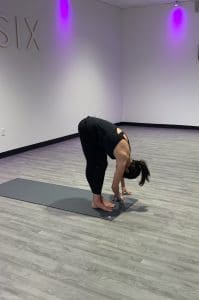UPDATED May 1, 2022: Yoga for runners is like eating vegetables. We know we should do it. We know it is good for us. But we don’t do it.
For most mother runners, it comes down to time. We simply don’t have time to do yoga. But I make the argument that yoga for runners is worth the time because it can make us better runners. If you have to shave a mile off your
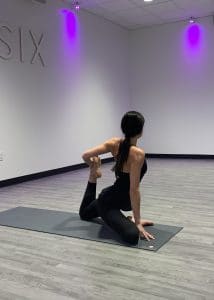
run to do 10 minutes of yoga, you should. The benefits of this yoga routine for runners below may likely outweigh that of an extra mile.
In this article, I am going to share:
- why yoga is good for runners
- what type of yoga is best for runners
- when runners should do yoga
- how often should runners do yoga
- does yoga make you run faster?
- plus, six yoga poses for runners
So, let’s go!
Is yoga good for runners?
Yes, yoga is good for runners because yoga improves mobility which is crucial for injury prevention and running performance. Here are some benefits of yoga:
- Yoga improves mobility in runners by moving through full ranges of motion for the joints and muscles. This also improves the flow of synovial fluid, important for the lubrication and overall health of joints. This can help decrease risk of injury.
- Yoga also can address overly tight areas before they turn into running injuries. It can also increase awareness around areas of the body that may need more attention such as a proper warm-up or activation before running.
- Yoga is also good for a runner’s mindset. It can quiet the mind, reduce stress, and increase gratitude and awareness of your body.
Note that while yoga is good for flexibility, runners do not want to be overly flexible. We want our leg muscles to be like tight springs that recoil into the ground with a force that propels us forward.
Mobility, as opposed to flexibility, refers to the overall range of motion of our joints. The more range of motion our joints have, the better running efficiency we can have. This means you can run faster easier.
What type of yoga is good for runners?
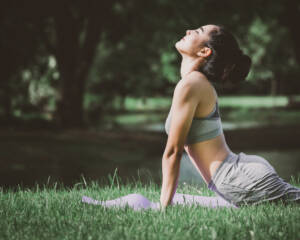
Slow flow yoga is best for runners and their recovery. Slow flow yoga involves flowing through yoga poses at a slower rate. You take about 3 to 5 breaths in each pose before flowing into the next.
Slow flow yoga is great for circulation, key to helping your muscles recover faster, and mobility, key for running efficiency.
If you are looking for a deep stretch, yin yoga is best.
If you looking to get stronger with yoga, ashtanga yoga and power yoga are best for strengthening your muscles.
I recommend runners do strength training with weights (working up to heavy weights) to improve running performance. Research shows that lifting weights can help you run faster. So, if you’re looking to get stronger, I advise lifting over doing yoga.
Related: Your Strength Training Guide for Runners
When should runners do yoga?
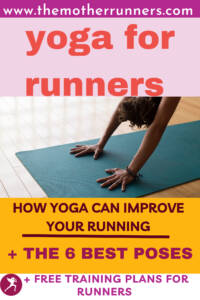
Runners should do yoga after their runs or on a rest day (if it is relaxed yoga class such as slow flow). You do not want to perform static stretches before a run, or else you risk injury and reduced performance.
However, a short yoga sequence (such as the one below) as part of your running recovery after a run or on a rest day can help you feel better and improve mobility.
How often should runners do yoga?
Runners should aim to do a yoga sequence at least two times a week. In a perfect world, we would be able to carve out two hours a week for yoga. But that’s not likely.
Instead, I recommend you sprinkle in this short yoga sequence after hard running days, on your rest day, and/or whenever you have time. If you can do a yoga class on a rest day or cross-training day, do it!
Related: The Best Cross-training Exercises for Runners
I aim to do these yoga poses after a run, or if I don’t have time then, during my kids’ bath time. I’m also a fan of Peloton’s Yoga for Runners and Yoga with Adriene. And if you can find an in-person yoga teacher you like, all the better!
Related: Do Massage Guns Really Help Runners? A Theragun Review
Does yoga make you run faster?
There isn’t a massive study that proves that yoga will make you run faster. But the evidence is there.
Yoga for runners may improve:
- physical strength
- mobility
- circulation
- cardiovascular health
- stress levels
- mental strength
- body alignment and
- body awareness.
These are all components that can improve your running economy, running performance, running form, and running health.
So, yes, yoga can make you run faster. However, there can be too much of a good thing.
Runners should avoid holding long poses multiple times a week. This makes your muscles too flexible, decreasing running performance (we want our muscles like tight springs that release force into the ground to propel us forward) and predisposing us to running injuries.
This is why I recommend slow flow yoga in which you move through poses rather quickly (not holding for minutes at a time) increasing circulation and mobility.
So, let’s get the 6 best yoga poses for runners according to mother runner and instructor and manager of Yoga Six, Ashly Sims.
Related: Free Training Plans
6 Yoga Poses for Runners
Here is a Yoga for Runners routine that takes less than 5 minutes but packs a lot of benefits. A couple of notes about these yoga poses for runners:
- Aim to do these yoga poses after your run as part of a recovery or on a rest day.
- Hold each pose for 5 to 8 breaths.
- If you do not have 5 minutes, do the Gorilla and Lizard poses, or whatever feels best.
- Use a book or pillow as yoga blocks for extra support and length.
- In between the poses, feel free to move into vinyasa flow in which you:
- lay on your stomach
- push up on your forearms so that your back is arched
- then move into a downward dog in which your hips are in the air and head between your arms in an upside-down V shape.
Related: 6 Strength Moves for Runners
Pose 1: Lizard
The Lizard Pose is a great stretch for runners and their hip flexors, hamstrings, and quadriceps. Incorporating Lizard into your yoga practice can help to improve the flexibility of your hip ligaments and strengthen the muscles in your legs.
Here’s how to do it:
- Start in down dog.
- Step right foot to the front of your mat.
- Lower your back knee into a low lunge.
- With your hands on the ground-gently extend the left leg back until you feel an opening in your left hip flexor.
- From there, walk your right foot out to the inner edge of your mat and open up your foot by pressing the outer edge of the foot into the mat.
- Place hands on the ground or for a deeper stretch, place forearms on the ground to the right of the front foot for an even deeper stretch.
- Release your head and neck and allow your left hip to sink towards the ground with each exhale.
- Most importantly, breathe. Don’t hold your breath.
- Hold.
- Repeat on the other side.
Pose 2: Half Pigeon
The Half Pigeon stretches hip flexors, opens gluteus maximus, and helps relax the piriformis muscles.
Here’s how to do it:
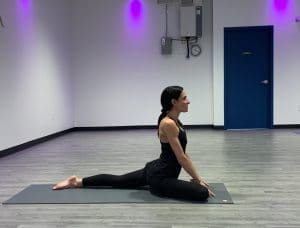
- Start in down dog.
- Bring shin to the front of your mat. Many teachers will cue you to get your shin parallel to the mat but let’s get real, that’s challenging, especially for us runners. Instead, try to reach your front knee towards your wrist and let your shin follow.
- Release your back leg down and level hips to your mat.
- Sit up tall with a long spine.
- Walk hands back towards your hips.
- Inhale. Exhale as you sink your hips to the floor with them square to the mat.
- You can stay here. Or walk hands to the front and release down to the forearms. For a more relaxing version, stack a few pillows in front of you and rest your chest.
- Hold.
- Repeat on the other side.
Pose 3: Half Pigeon with Quad stretch
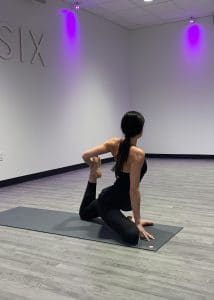
Half pigeon with quad stretch stretches your hip flexors and quads, opens the gluteus maximus, and helps relax the piriformis muscles.
Here’s how to do it:
- Follow the above instructions for half pigeon.
- Walk hands back towards your hips.
- Bend the extended leg behind and take the ankle in your hand as you bring your foot towards your seat.
- Hold.
- If you are in need of some extra length, use a towel to wrap around your foot, grab it, and pull towards your body.
- Repeat on the other side.
Related: How to Prevent, Treat & Diagnose Running Injuries
Pose 4: Fire log
The Fire Log Pose stretches the outer hips intensely, particularly the piriformis.
Here’s how to do it:
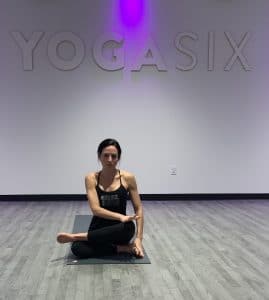
- Sit on one edge of a thickly-folded blanket with your knees bent and feet on the floor.
- Lightly shrug your shoulders up and strongly roll the tops of your upper arm bones back.
- Press the bottom tips of your shoulder blades into your back.
- Slide your left foot under your right leg to the outside of your right hip, and lay the bottom (left) leg on the floor.
- Then, stack your right leg on top of the left. Be sure the right ankle is on outside the left knee (so the sole is perpendicular to the floor).
- You can slide your left shin forward directly below the right to increase the challenge; otherwise, keep the left heel beside the right hip.
- Hold.
- Repeat on the other side.
Pose 5: Gorilla Pose
This pose stretches the backs of the legs (your hamstrings and calves), helping to lengthen and strengthen those tight muscles. It also gives you an opportunity to relax the neck and shoulders.
Here’s how to do it:
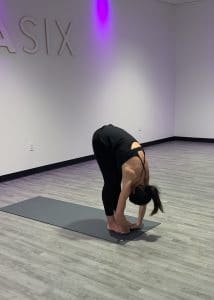
- Start with feet hip distance apart.
- Bend your knees and fold forward.
- Allow your hands to slip under your feet, bringing your toes to your wrists.
- Bend your knees as much as your body needs.
- Once your hands are under your feet, inhale as you lift up with a flat back.
- Hold.
- Exhale to fold deeper and with each breath- create more length in the back of the leg by straightening the legs even more.
Pose 6: Forward Fold with a Twist
This pose stretches the back of the legs and the IT band (notoriously tight for
runners).
Here’s how to do it:
- Cross your feet, bringing them together evenly with your pinky toes touching.

Forward Fold with a Twist stretches the backs of the legs (your hamstrings and calves), helping to lengthen and strengthen those tight muscles. - Bend your knees.
- Allow your fingertips to touch the floor (or put them to the back of your legs).
- Cross your right leg in front of your left.
- Walk your hands to the outside of the left foot (or take the left calf muscle in your hands).
- Breathe and fold deeper with each exhale.
- Repeat on the other side.
If you need help reaching your running goals (including optimizing your recovery), check out my run coaching services.
Also, be sure to check out my free training plans:
- Postpartum Training Plan
- After a Break Training Plan
- 5k Training Plans
- 10k Training Plans
- Half Marathon Training Plans
- Marathon Training Plans
- Strength Training Plan

